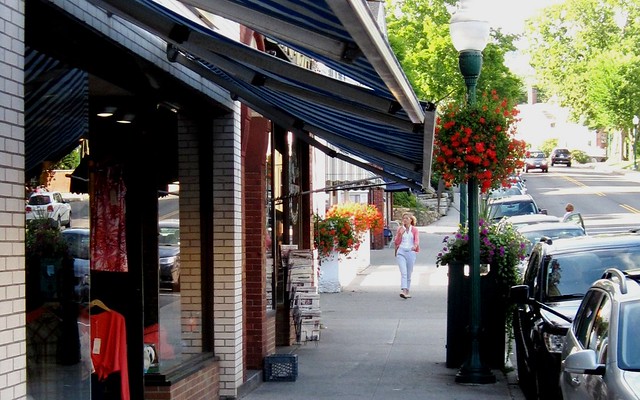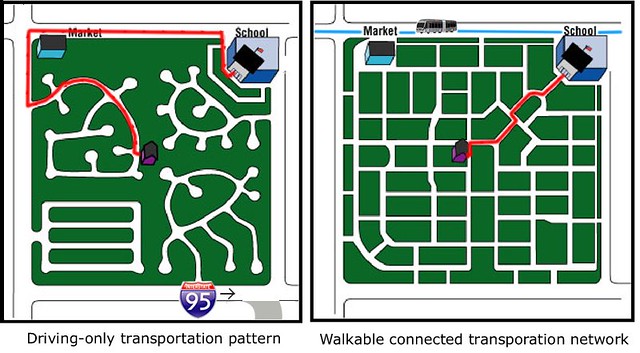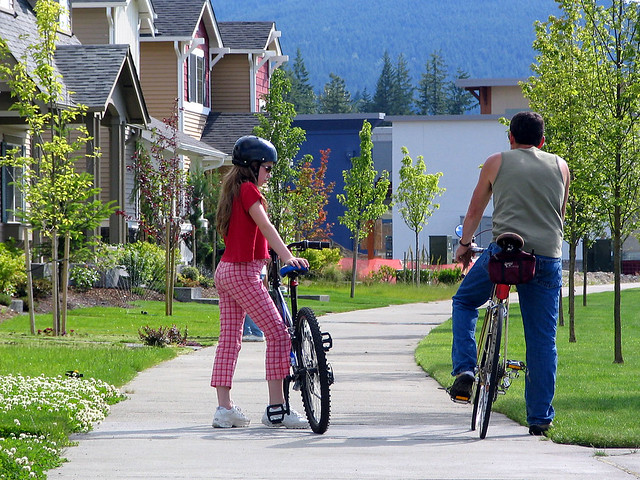Compact and connected communities improve public health, says new research

Posted October 20, 2014 at 2:50PM
We know from exhaustive past research that walkable neighborhoods and cities reduce driving, associated emissions, and living costs. Three important academic studies published earlier this year demonstrate that they are good for our health, too.
In particular, the research, which examines different aspects of compact, walkable, and mixed-use communities and compares those aspects to published government health data, finds that such neighborhoods and cities are strongly associated with reduced rates of obesity, high blood pressure, heart disease, and diabetes. The reason is close to a tautology: walkable environments encourage walking, which in turns facilitates good health. While researchers are careful to point out that many other factors facilitate good health as well, the results hold up even when the studies are controlled to eliminate those other factors from consideration.
What’s a walkable neighborhood, anyway?
While, as noted, the different researchers involved in the three studies assess different characteristics of urban form, all generally accept the definition put forth by University of Arizona researchers Emily Talen and Julia Koschinsky in the opening paragraph of their study:
“It is a neighborhood type defined by services within walking distance of residents, a pedestrian orientation that minimizes car dependence, and a level of density and land-use diversity that is higher than the typical American suburb . . . Our focus is on the general parameters of the compact, walkable, and diverse neighborhood as a type distinct from auto-dependent, single-use suburbs.”
The distinction is thus drawn between so-called “smart growth” neighborhoods, on the one hand, and conventional suburban “sprawl,” on the other. Aspects of these characteristics are measured at the county scale in one of the other two studies, and at both the neighborhood and city scales in the other.
Defining the characteristics of our neighborhoods and cities that promote walking and health is critical, because the US is suffering a serious obesity epidemic that is getting worse rather than better. Over 68 percent of American adults are now overweight or obese, a percentage that has more than doubled since 1960. One in three children is overweight or obese, triple the number from a generation ago.
Indeed, government data indicate that 36 percent of adults are now classified as obese, and 17 percent of youth are obese. If these trends continue, nearly half of all Americans could be obese 20 years from now.
I’m certainly not going to argue that land use, and resulting automobile dependence, are the only reasons for overweight and obesity in the US, or even the only reasons why we now fail to get enough exercise. But these new studies add to the growing evidence that they are significant contributing factors. They should be taken into account as we plan for a healthier future and, I would argue, more choices for our growing population as we seek places to live, work, shop, and play.
(Before diving in further, I have to say that slogging through academic literature is not for the timid. In addition to the usual complex mathematical equations, one encounters terms such as “eigenvalue,” “log-likelihood ratios,” “construct validity,” and “link-to-node ratio.” But I digress.)
Compactness versus sprawl at the county scale
A team of scholars at the University of Utah, led by Reid Ewing, examined land-use data from 995 counties nationwide, constructing a compactness-versus-sprawl “index” based on an equally weighted combination of four factors: development density, street accessibility, land use diversity (or lack thereof), and population and employment centering (or lack thereof). The team then compared the counties’ indices to self-reported health data from the massive Behavioral Risk Factor Surveillance System, managed by the federal Centers for Disease Control and Prevention. The key finding: residents of more compact and diverse counties exhibit, on average, lower body mass indices and lower rates of obesity, diabetes, heart disease, and high blood pressure when compared to residents of more sprawling counties.
(Disclosure: Ewing is a personal friend. My only knowledge of the study, though, is through reading the report in the peer-reviewed journal Health & Place.)
Ewing and his colleagues discuss, as they should, the abundance of factors other than land use that affect health. In the study, they controlled for gender, age, race and ethnicity, income, and educational attainment. They also looked at the incidence of smoking and fruit and vegetable consumption.
The researchers note that “the most compact counties are as expected, central counties of large, older metropolitan areas. The most sprawling counties are outlying counties of large metropolitan areas, or component counties of smaller metropolitan areas.” They observe that the counties rated as most sprawling according to the study’s four-factor index – those with the highest rates of obesity and reported disease – have census tracts with “very low residential densities, commercial strips, and cul-de-sac street networks.”
The team also discusses the relevance of examining data at the county scale, noting that “most investigators have chosen to characterize the built environment of individuals at the neighborhood scale.” This, they believe, is in part due to a debatable assumption that walking distance from home is the operative scale at which the built environment affects physical activity, food availability, and ultimately weight. In fact, the researchers contend, both the macro and the micro scales are relevant:
“Adults spend most of their waking hours away from home. An estimated 30–40 percent of all trips are non-home-based. A sprawling metropolitan area produces long commutes, which cut into leisure time and hence physical activity. Access to healthy foods may be more difficult in sprawling environments.”
Put another way, when we leave our homes, the characteristics of the places through and to which we travel may matter as much as those of our home neighborhood. As it turns out, this proposition was supported in the next study.
The influence of street networks
Street networks can have a profound effect on the amount of walking that takes place in a community. Let’s say we want to travel from a restaurant to a Toys R Us store in a standard suburban environment. If one could walk in a straight line, they might be only a five minute walk from each other. But, if the street configuration requires that we go back to the arterial road, with no safe way to get across the street, chances are we’re going to drive, perhaps as much as a mile to get conveniently from the restaurant to the store.
If streets and sidewalks are well-connected, however, and there is a safe crosswalk, with a more moderately sized street, as might be the case in a traditional Main Street environment, we might choose to walk, enabling some of the health benefits that accompany walking.
The connections between street layout and health were the focus of a study led by Wesley Marshall of the University of Colorado-Denver and reported earlier this year in the Journal of Transport & Health. The authors examined three aspects of street networks – street connectivity, street network density, and street configuration – in 24 medium-sized California cities and, as did Ewing’s group, compared the land use indices to an expansive health database. The results were tabulated at both the neighborhood scale and the city scale. (Recall that street accessibility, a closely related measure, was one of the four factors studied by Ewing’s team at the county level.)
After controlling for other potential influences, the Marshall team arrived at findings remarkably similar to those of the Ewing team:
“We control for the food environment, land uses, commuting time, socioeconomic status, and street design. The results suggest that more compact and connected street networks with fewer lanes on the major roads are correlated with reduced rates of obesity, diabetes, high blood pressure, and heart disease among residents.”
The researchers also examined asthma rates, but did not find any statistically significant correlation between asthma and street networks.
Importantly, when comparing intersection density and street network density to incidence of disease, the correlation between compact and connected networks and reduced rates of disease was much stronger at the city scale than at the neighborhood scale. This adds weight to my long-held belief that context matters: you can’t expect to plop a so-called “urbanist” neighborhood design in a greenfield or highly suburban environment and expect to get the same environmental benefits as when constructing a similar neighborhood on an urban infill site.
The researchers put it this way:
“[B]etter health outcomes are more strongly associated with living in a compact city than a compact neighborhood surrounded by a sparse city. This is an important result in that many new developments focus on building urban enclaves with high intersection densities in the middle of more suburban environments. Such developments have many benefits but may not be optimal for public health . . .”
The authors conclude that “the role of the street network and how we put together the bones of our communities should not be overlooked as a potential contributing factor to health outcomes.”
A body of corroborating research
This brings me to Talen and Koschinsky’s work. The two University of Arizona researchers conducted an exhaustive review of literature examining the connections between land use factors – particularly those associated with compact, walkable and diverse neighborhoods – and outcomes related to health, social relations, and safety.
After reviewing over 200 articles, the authors focused their closest examination on 95 reports of empirical and scholarly research, published within the last decade in peer-reviewed publications. Sixty-four of those studies examined health effects and, of that subset, 50 were found to support the view that the effects of compact, walkable, and diverse neighborhoods are mostly positive on health outcomes. The remainder showed no clear positive or negative effect; none showed a negative effect.
After analyzing the particular studies in more detail, Talen and Koschinsky summarized their key finding regarding neighborhoods and health:
“[O]verall, the vast majority of studies show that built-environment effects are generally in one direction: People living in [compact, walkable, and diverse] neighborhoods, especially places defined by accessibility and gridded street networks, tend to have higher health ratings, with an important caveat being that these relationships may not hold where there is significantly high crime and high poverty. Most, although not all, meta-analyses summarizing these relationships have concluded that there are strong correlations overall.” (Citations omitted.)
Concerning neighborhoods and social relations, the authors observe that many studies find that compact and walkable neighborhoods exhibit higher levels of social interaction, a “substantially greater sense of community,” stronger place attachment, and higher levels of trust than do conventional sprawling subdivisions. Talen and Koschinsky found 11 studies positively linking social benefits to compact neighborhoods, with only one showing a negative effect; one also showed no clear effect one way or the other.
Finally, the authors cite 12 studies linking safety benefits to compact, walkable, and diverse neighborhoods, while noting that none showed mostly negative effects and five found no clear positive or negative effect. Talen and Koschinsky argue that safety is positively related to such neighborhoods for two reasons: first, a reduced emphasis on unimpeded vehicle flow makes places safer for both drivers and pedestrians; and, second, compact urban forms produce more street life, a deterrent against crime.
Move your cursor over the images for credit information.
Related posts:
- The daunting challenge of unwalkable America (excerpted from People Habitat) (September 2, 2014)
- Pedestrian safety leads to more walking, or is it vice versa? (May 30, 2014)
- What makes a good Main Street work? (May 27, 2014)
- Dan Burden, articulate on how to create walkable communities (January 20, 2014)
- We're driving less, taking transit more. Now let's invest accordingly. (December 5, 2013)
- 5 graphs and 4 photos tell the story on obesity, diabetes & walking (March 28, 2012)



